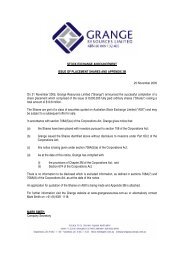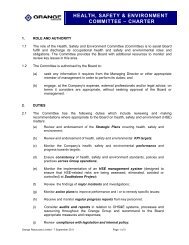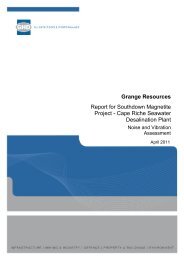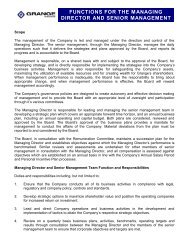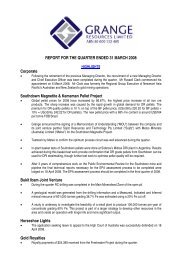2012 Annual Report (2 April 2013) - Grange Resources
2012 Annual Report (2 April 2013) - Grange Resources
2012 Annual Report (2 April 2013) - Grange Resources
Create successful ePaper yourself
Turn your PDF publications into a flip-book with our unique Google optimized e-Paper software.
54<br />
PAGE<br />
<strong>2012</strong> ANNUAL REPORT<br />
Notes to the Financial Statements (cont.)<br />
NOTE 1. SUMMARY OF SIGNIFICANT<br />
ACCOUNTING POLICIES (cont.)<br />
(u)<br />
Investments and other financial assets<br />
Classification<br />
The Group classifies its financial assets in the following categories:<br />
financial assets at fair value through profit and loss, loans and<br />
receivables, held-to-maturity financial assets and available-for-sale<br />
financial assets. The classification depends on the purpose for<br />
which the investments were acquired. Management determines<br />
the classification of its investments at initial recognition, and in<br />
the case of assets classified as held-to-maturity, re-evaluates this<br />
designation at each reporting date.<br />
Financial assets at fair value through profit or loss<br />
Financial assets classified as held for trading purposes are<br />
included in the category ‘financial assets at fair value through<br />
profit or loss’. Financial assets are classified as held for trading<br />
if they are acquired for the purpose of selling in the near term.<br />
Derivatives are also classified as held for trading unless they are<br />
designated as effective hedging instruments. Gains or losses on<br />
investments held for trading are recognised in profit or loss.<br />
Loans and receivables<br />
Loans and receivables are non-derivative financial assets with<br />
fixed or determinable payments that are not quoted in an active<br />
market. Such assets are carried at amortised cost using the<br />
effective interest method. Gains and losses are recognised in the<br />
profit and loss when the loans and receivables are derecognised<br />
or impaired, as well as through the amortisation process.<br />
Held-to-maturity investments<br />
Bills of exchange and debentures are recorded at amortised cost<br />
using the effective interest method less impairment, with revenue<br />
recognised on an effective yield basis.<br />
The effective interest method is a method of calculating the<br />
amortised cost of a financial asset and of allocating interest<br />
income over the relevant period. The effective interest rate is the<br />
rate that exactly discounts estimated future cash receipts through<br />
the expected life of the financial asset, or, where appropriate, a<br />
shorter period.<br />
Available-for-sale financial assets<br />
Financial assets that are available-for-sale are stated at fair value<br />
less impairment. Gains and losses arising from changes in fair<br />
value are recognised directly in the available-for-sale revaluation<br />
reserve, until the investment is disposed of or is determined to<br />
be impaired, at which time the cumulative gain or loss previously<br />
recognised in the available-for-sale revaluation reserve is included<br />
in profit or loss for the period.<br />
(v) Derivative financial instruments<br />
The Group enters into a variety of derivative financial instruments<br />
to manage its exposure to foreign exchange rate risk.<br />
Derivatives are initially recognised at fair value on the date<br />
a derivative contract is entered into and are subsequently<br />
remeasured to their fair value at each reporting date. The resulting<br />
gain or loss is recognised in profit or loss immediately unless the<br />
derivative is designated and effective as a hedging instrument, in<br />
which event, the timing of the recognition in profit or loss depends<br />
on the nature of the hedge relationship. The company designates<br />
certain derivatives as either hedges of the fair value of recognised<br />
assets or liabilities or firm commitments (fair value hedges) or<br />
hedges of highly probable forecast transactions (cash flow<br />
hedges), or hedges of net investments in foreign operations.<br />
Fair value hedge<br />
Changes in the fair value of derivatives that are designated<br />
and qualify as fair value hedges are recorded in profit or loss<br />
immediately, together with any changes in the fair value of the<br />
hedged asset or liability that is attributable to the hedged risk.<br />
Hedge accounting is discontinued when the hedge instrument<br />
expires or is sold, terminated, exercised, or no longer qualifies for<br />
hedge accounting. The adjustment to the carrying amount of the<br />
hedged item arising from the hedged risk is amortised to profit or<br />
loss from that date.<br />
Cash flow hedge<br />
The effective portion of changes in the fair value of derivatives<br />
that are designated and qualify as cash flow hedges are deferred<br />
in equity. The gain or loss relating to the ineffective portion is<br />
recognised immediately in profit or loss.<br />
Amounts deferred in equity are recycled in profit or loss in the<br />
periods when the hedged item is recognised in profit or loss.<br />
However, when the forecast transaction that is hedged results in<br />
the recognition of a non-financial asset or a non-financial liability,<br />
the gains and losses previously deferred in equity are transferred<br />
from equity and included in the initial measurement of the cost of<br />
the asset or liability.<br />
Hedge accounting is discontinued when the hedging instrument<br />
expires or is sold, terminated, or exercised, or no longer qualifies<br />
for hedge accounting. At that time, any cumulative gain or loss<br />
deferred in equity at that time remains in equity and is recognised<br />
when the forecast transaction is ultimately recognised in profit<br />
or loss. When a forecast transaction is no longer expected to<br />
occur, the cumulative gain or loss that was deferred in equity is<br />
recognised immediately in profit or loss.



